Andreas Gursky: Visual Spaces of Today

Andreas Gursky, Salinas, 2021 © Andreas Gursky, VG Bild-Kunst, Bonn, Germany
Dal 25 May 2023 al 7 January 2024
Bologna
Luogo: Fondazione MAST
Indirizzo: Via Speranza 42
Curatori: Urs Stahel, Andreas Gursky
E-Mail info: gallery@fondazionemast.org
Sito ufficiale: http://www.mast.org
Andreas Gursky: Visual Spaces of Today features forty works by Gursky selected by the artist and Fondazione MAST curator Urs Stahel and spanning his career. Drawing inspiration from the foundation’s name—the acronym stands for “Manifattura di Arti, Sperimentazione, e Tecnologia”—and its focus on art, innovation, and technology, the works aim to reflect these themes.
You never notice arbitrary details in my work. On a formal level, countless interrelated micro and macrostructures are woven together, determined by an overall organizational principle.
—Andreas Gursky
From images of nature to photographs of cities, crowds, and commercial products, Andreas Gursky invents new worlds from existing elements, constructing tableaux based on his methodical observations. In his large-format, high-definition photographs, he presents hyperfocused scenes that privilege neither foreground nor background.
Gursky studied visual communication at the Folkwang Universität der Künste in Essen, Germany, from 1977 to 1980. He then continued his studies at the Kunstakademie Düsseldorf, where he was a master-class student of Bernd and Hilla Becher, the artist duo known for their series of photographs of selected types of industrial structures, or “typologies.” While the Bechers used a standardized, documentary style to underscore the commonality inherent in variation, Gursky’s studies propelled him to expand the idea of the photographic document by using digital manipulation and montage to record specific scenes, moments, and events. His works from the early 1990s depict factories, stock exchanges, airports, golf courses, highways, and buildings, often from aerial viewpoints that reveal the patterns of crowds and infrastructure. In 1996 he moved away from this perspective in favor of deadpan frontal views, as in the Pradaseries (1996–98), depicting the minimalist altars of luxury fashion, or, as in Prada II (1997), showing the empty shelves lit with fluorescent lights.
In the early 2000s Gursky began arranging his photographic montages according to classical patterns of representation. The Pyongyangphotographs (2007), in particular—which show colorful, kaleidoscopic crowds of performers in North Korea—recall compositional methods used during the Renaissance. Gursky followed this series with photographs of more informal crowds, such as those at Cocoon, a famous German nightclub designed by his friend DJ Sven Väth. The club, with its perforated metallic walls, resembles a futuristic hive, and Gursky used its cavernous scale to produce hypnotic scenes that envelop the viewer in their repeated patterns.
In addition to his work focusing on social phenomena, entertainment, and urban planning, Gursky is interested in capturing the realities of the planet, often narrowing in on bodies of water, from the Rhine in Germany to the Chao Phraya in Thailand. The Bangkok series (2011) depicts the flickering, often littered, surface of this fast-flowing river at close range. For the Oceanworks (2010), Gursky sourced high-definition satellite photography to generate his own interpretations of sea and land, constructing scenes of oceanic expanses with coastlines visible at the images’ outermost edges. From environmental threats to growing crowds and infrastructural development, Gursky’s photographs capture the extremes of the present moment.
You never notice arbitrary details in my work. On a formal level, countless interrelated micro and macrostructures are woven together, determined by an overall organizational principle.
—Andreas Gursky
From images of nature to photographs of cities, crowds, and commercial products, Andreas Gursky invents new worlds from existing elements, constructing tableaux based on his methodical observations. In his large-format, high-definition photographs, he presents hyperfocused scenes that privilege neither foreground nor background.
Gursky studied visual communication at the Folkwang Universität der Künste in Essen, Germany, from 1977 to 1980. He then continued his studies at the Kunstakademie Düsseldorf, where he was a master-class student of Bernd and Hilla Becher, the artist duo known for their series of photographs of selected types of industrial structures, or “typologies.” While the Bechers used a standardized, documentary style to underscore the commonality inherent in variation, Gursky’s studies propelled him to expand the idea of the photographic document by using digital manipulation and montage to record specific scenes, moments, and events. His works from the early 1990s depict factories, stock exchanges, airports, golf courses, highways, and buildings, often from aerial viewpoints that reveal the patterns of crowds and infrastructure. In 1996 he moved away from this perspective in favor of deadpan frontal views, as in the Pradaseries (1996–98), depicting the minimalist altars of luxury fashion, or, as in Prada II (1997), showing the empty shelves lit with fluorescent lights.
In the early 2000s Gursky began arranging his photographic montages according to classical patterns of representation. The Pyongyangphotographs (2007), in particular—which show colorful, kaleidoscopic crowds of performers in North Korea—recall compositional methods used during the Renaissance. Gursky followed this series with photographs of more informal crowds, such as those at Cocoon, a famous German nightclub designed by his friend DJ Sven Väth. The club, with its perforated metallic walls, resembles a futuristic hive, and Gursky used its cavernous scale to produce hypnotic scenes that envelop the viewer in their repeated patterns.
In addition to his work focusing on social phenomena, entertainment, and urban planning, Gursky is interested in capturing the realities of the planet, often narrowing in on bodies of water, from the Rhine in Germany to the Chao Phraya in Thailand. The Bangkok series (2011) depicts the flickering, often littered, surface of this fast-flowing river at close range. For the Oceanworks (2010), Gursky sourced high-definition satellite photography to generate his own interpretations of sea and land, constructing scenes of oceanic expanses with coastlines visible at the images’ outermost edges. From environmental threats to growing crowds and infrastructural development, Gursky’s photographs capture the extremes of the present moment.
SCARICA IL COMUNICATO IN PDF
COMMENTI

-
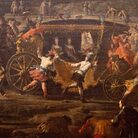 Dal 20 December 2025 al 20 April 2026
Caserta | Reggia di Caserta
Dal 20 December 2025 al 20 April 2026
Caserta | Reggia di Caserta
Regine: trame di cultura e diplomazia tra Napoli e l’Europa
-
 Dal 19 December 2025 al 23 March 2026
Torino | Palazzo Madama - Museo Civico d’Arte Antica
Dal 19 December 2025 al 23 March 2026
Torino | Palazzo Madama - Museo Civico d’Arte Antica
Il castello ritrovato. Palazzo Madama dall’età romana al medioevo
-
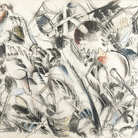 Dal 17 December 2025 al 19 January 2026
Roma | Palazzo della Cancelleria
Dal 17 December 2025 al 19 January 2026
Roma | Palazzo della Cancelleria
De Humana Mensura di Linda Karshan
-
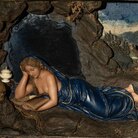 Dal 18 December 2025 al 12 April 2026
Firenze | Gallerie degli Uffizi
Dal 18 December 2025 al 12 April 2026
Firenze | Gallerie degli Uffizi
Cera una volta. Sculture dalle collezioni medicee
-
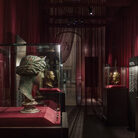 Dal 11 December 2025 al 9 April 2026
Firenze | Museo Archeologico Nazionale di Firenze
Dal 11 December 2025 al 9 April 2026
Firenze | Museo Archeologico Nazionale di Firenze
Icone di Potere e Bellezza
-
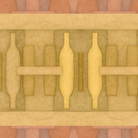 Dal 11 December 2025 al 11 January 2026
Roma | Palazzo Esposizioni Roma
Dal 11 December 2025 al 11 January 2026
Roma | Palazzo Esposizioni Roma
Giorgio Morandi nella Collezione Eni. Un viaggio attraverso la storia culturale del cane a sei zampe e l’eredità di Enrico Mattei


